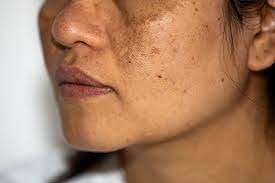
Introduction
Melasma Treatment in Abu Dhabi is a common skin condition characterized by brown or gray-brown patches, primarily on the face. It often appears on the cheeks, forehead, nose, and chin, affecting both men and women, though it is more prevalent in women. Addressing melasma is crucial not only for aesthetic reasons but also for overall skin health and self-confidence.
Understanding Melasma
Melasma occurs due to the overproduction of melanin, the pigment responsible for skin color.
Causes of Melasma
While the exact cause is not fully understood, several factors can contribute to its development:
- Sun Exposure: Ultraviolet (UV) rays can stimulate melanin production.
- Hormonal Changes: Fluctuations during pregnancy, birth control use, or hormone replacement therapy can trigger melasma.
- Genetics: A family history of melasma can increase the likelihood of developing it.
- Certain Medications: Some medications may cause pigmentation changes in the skin.

Common Symptoms and Characteristics
The most noticeable symptom of melasma is the appearance of dark patches on the skin. These patches can vary in size and may be symmetrical, often presenting on both sides of the face.
Types of Melasma
Melasma is classified into three types based on the depth of the pigmentation:
- Epidermal Melasma: Shallow pigmentation that appears brown and is typically easier to treat.
- Dermal Melasma: Deeper pigmentation that appears blue-gray and may require more intensive treatment.
- Mixed Melasma: A combination of both epidermal and dermal types.
Diagnosis of Melasma
How Melasma is Diagnosed
Diagnosis typically involves a visual examination by a dermatologist. In some cases, a Wood’s lamp examination or skin biopsy may be performed to determine the type and depth of pigmentation.
Importance of Professional Evaluation
A professional evaluation is essential to rule out other skin conditions that may resemble melasma and to develop a tailored treatment plan.
Melasma Treatment Options in Abu Dhabi
Abu Dhabi offers a variety of effective treatments for melasma, ensuring patients have access to the latest advancements in skincare.
Topical Treatments
Over-the-counter creams containing hydroquinone, kojic acid, and retinoids can help lighten melasma. Prescription-strength options are also available through dermatologists.
Laser Therapy
Laser treatments, such as fractional laser and Q-switched lasers, target the pigmented areas without damaging surrounding skin, offering a more permanent solution.
Chemical Peels
Chemical peels utilize acids to exfoliate the skin’s outer layer, helping to reduce the appearance of melasma. Superficial peels are generally recommended for best results.
Microneedling
This procedure involves using fine needles to create micro-injuries in the skin, promoting collagen production and allowing for better absorption of topical treatments.
Intense Pulsed Light (IPL) Therapy
IPL therapy uses light energy to target and break down melanin in the skin, reducing pigmentation and improving overall skin tone.
Choosing the Right Treatment
Factors to Consider
Selecting the appropriate treatment for melasma depends on various factors, including the severity of the condition, skin type, and individual preferences.
Importance of a Personalized Approach
Consulting with a qualified dermatologist can help determine the most effective treatment plan tailored to individual needs.
Benefits of Melasma Treatment
Improvement in Skin Appearance
Effective treatment can significantly reduce the appearance of dark patches, leading to a more even skin tone and improved texture.
Boost in Self-Confidence
Addressing melasma can enhance self-esteem, allowing individuals to feel more comfortable and confident in their skin.
Side Effects and Considerations
Potential Side Effects of Treatments
While most treatments are safe, they may come with potential side effects such as redness, swelling, or peeling. Understanding these risks is essential.
Importance of Discussing Risks with a Dermatologist
A thorough consultation with a dermatologist will help patients understand the risks associated with each treatment option.
Aftercare and Maintenance
Skincare Routine Post-Treatment
Following treatment, it’s vital to maintain a gentle skincare routine, avoiding harsh products that may irritate the skin.
Importance of Sun Protection
Sun exposure can exacerbate melasma, making daily sun protection a crucial part of aftercare. Broad-spectrum sunscreen with a high SPF is recommended.
Lifestyle Changes to Manage Melasma
Dietary Considerations
A diet rich in antioxidants, vitamins, and minerals can support skin health and may aid in reducing melasma. Foods such as fruits, vegetables, and nuts are beneficial.
Importance of Hydration
Staying well-hydrated helps maintain skin elasticity and can improve overall skin appearance.
Stress Management
Stress can trigger hormonal fluctuations that may worsen melasma. Techniques such as yoga, meditation, and regular exercise can help manage stress levels.
The Role of Dermatologists in Melasma Treatment
Expertise in Diagnosis and Treatment
Dermatologists possess the expertise necessary to accurately diagnose melasma and recommend appropriate treatments based on individual needs.
Importance of Ongoing Care and Follow-Ups
Regular follow-up appointments ensure that treatment plans are effective and allow for adjustments as needed.
Real Patient Experiences
Testimonials from Patients Who Have Undergone Treatment
Many patients report positive experiences with melasma treatment, citing significant improvements in their skin’s appearance.
Success Stories
Success stories often highlight the effectiveness of tailored treatments and the life-changing impact on patients’ self-confidence.
Addressing Common Myths About Melasma
Debunking Misconceptions
There are many myths surrounding melasma, such as the idea that it only affects women or that it cannot be treated effectively.
Clarifying Facts vs. Myths
Melasma can affect anyone, and with the right treatment, it can be successfully managed.
Conclusion
Melasma is a common yet manageable skin condition that affects many individuals in Abu Dhabi. With a variety of treatment options available, seeking professional help is the first step towards achieving a clearer complexion and boosting self-esteem. By understanding the available treatments and committing to a proper skincare routine, individuals can effectively manage and treat melasma.
Frequently Asked Questions (FAQs)
- What triggers melasma?
Sun exposure, hormonal changes, and genetics are common triggers. - Is melasma treatment painful?
Most treatments involve minimal discomfort, though pain thresholds vary among individuals. - How long does it take to see results from melasma treatment?
Results can vary, but many patients see improvement within a few weeks to a few months, depending on the treatment. - Can melasma come back after treatment?
Yes, melasma can recur, especially with sun exposure or hormonal changes. Regular maintenance and sun protection are essential. - Are there any home remedies for melasma?
While some natural remedies may help, they are often less effective than professional treatments. Consult a dermatologist for the best options.



